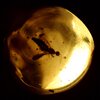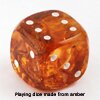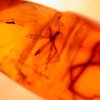 Used by man even before the ice age, natural amber gemstone can be categorized as an organic gem material of vegetable origin. Amber is not a mineral, but time-hardened fossilized resin of the species of pine called Pinus Succinisera. These trees grew in forests around 45 million years ago, in the European main land known to us as the Baltic region today!
Used by man even before the ice age, natural amber gemstone can be categorized as an organic gem material of vegetable origin. Amber is not a mineral, but time-hardened fossilized resin of the species of pine called Pinus Succinisera. These trees grew in forests around 45 million years ago, in the European main land known to us as the Baltic region today! Amber gemstone was used by Palaeoliyhic man in Austria from 45000 -12000 B.C. The nomadic hunters of the Nesolithic age (12000-4000 B.C.) used amber to hunt animals. They carved phases of the moon, hunting seasons and the animals that they hunted on amber.
Amber gemstone was used by Palaeoliyhic man in Austria from 45000 -12000 B.C. The nomadic hunters of the Nesolithic age (12000-4000 B.C.) used amber to hunt animals. They carved phases of the moon, hunting seasons and the animals that they hunted on amber. Amber gemstone was believed to possess magical power, since it was warm to touch, light weight, produced static electricity when rubbed and smelled sweet when heated. Wearing amber as an amulet was highly recommended to safeguard the wearer from evil and from negative energy.
Amber gemstone was believed to possess magical power, since it was warm to touch, light weight, produced static electricity when rubbed and smelled sweet when heated. Wearing amber as an amulet was highly recommended to safeguard the wearer from evil and from negative energy. The color of amber fossil varies from yellow to dark brown to almost black. Very rarely this gem may be found in green and blue-gray colors and hence green amber can be very rare. In addition, it is dyed in many colors like green, blue, pink etc. The color of this gem denotes the area from where it has originated. Baltic amber is yellow, Sicilian is reddish yellow, Rumanian is brown and Burmese is yellow to reddish-brown.
The color of amber fossil varies from yellow to dark brown to almost black. Very rarely this gem may be found in green and blue-gray colors and hence green amber can be very rare. In addition, it is dyed in many colors like green, blue, pink etc. The color of this gem denotes the area from where it has originated. Baltic amber is yellow, Sicilian is reddish yellow, Rumanian is brown and Burmese is yellow to reddish-brown. Amber gemstone is usually cut as beads and cabochons. Many times it is just polished and used in its crude rough shape. Opaque gems of big sizes are mostly used in carvings. Gems with inclusions are mainly fashioned as cabochons. Amber beads are popular choice for use in necklaces and bracelets.
Amber gemstone is usually cut as beads and cabochons. Many times it is just polished and used in its crude rough shape. Opaque gems of big sizes are mostly used in carvings. Gems with inclusions are mainly fashioned as cabochons. Amber beads are popular choice for use in necklaces and bracelets.
Carat
Amber gemstone is usually sold by piece and not by weight.
Clarity
Inclusions in amber gemstone actually serve to increase its value. Its transparency may vary from transparent to semi-translucent to opaque.
 During the process of fossilization, a variety of flora and fauna tend to remain trapped in the amber resin and eventually become an integral part of the final gem i.e. amber. Over the centuries fauna like larvae, caterpillars, bees, flies, butter flies, spiders and even land snails have been discovered in amber.
During the process of fossilization, a variety of flora and fauna tend to remain trapped in the amber resin and eventually become an integral part of the final gem i.e. amber. Over the centuries fauna like larvae, caterpillars, bees, flies, butter flies, spiders and even land snails have been discovered in amber.
Flora like wood fragments, leaves, flowers, other plant parts and ferns are also found in the gem. The more unique the fossils in amber, the higher its value. Other trapped flora and fauna, dust, small pyrite crystals and other minerals may also be found in this gemstone.
 An interesting piece of news about a piece of Dominican amber with inclusion is that recently, such a Dominican amber piece with a large lizard trapped inside it was sold for US$ 75000. Good pieces of wholesale amber beads can also be bought for as low as US$ 15. A carved amber ring is also very highly priced in the market.
An interesting piece of news about a piece of Dominican amber with inclusion is that recently, such a Dominican amber piece with a large lizard trapped inside it was sold for US$ 75000. Good pieces of wholesale amber beads can also be bought for as low as US$ 15. A carved amber ring is also very highly priced in the market. Some of the popular jewelry is comprised of Celtic amber jewelry and blue amber jewelry. However, a honey colored amber ring is always sought after by many buyers ? especially if it is a carved amber ring. Amber stone rings and amber mala are also very popular.
Some of the popular jewelry is comprised of Celtic amber jewelry and blue amber jewelry. However, a honey colored amber ring is always sought after by many buyers ? especially if it is a carved amber ring. Amber stone rings and amber mala are also very popular. Amber jewelry is usually made using silver, rather than gold because it gives the stone a very unique look. Small and large stones are fashioned into silver pendants and sold all over the world. The markets are full of various kinds of jewelry items such as amber earrings, amber bracelets, amber bead necklaces, and even amber stud earrings. A small piece of amber stone can be fashioned into a delicate silver wire wrap amber pendant. Depending on the design and the color, a number of great looking custom jewelry items can be created out of amber stones. These can make for wonderful gift items.
Amber jewelry is usually made using silver, rather than gold because it gives the stone a very unique look. Small and large stones are fashioned into silver pendants and sold all over the world. The markets are full of various kinds of jewelry items such as amber earrings, amber bracelets, amber bead necklaces, and even amber stud earrings. A small piece of amber stone can be fashioned into a delicate silver wire wrap amber pendant. Depending on the design and the color, a number of great looking custom jewelry items can be created out of amber stones. These can make for wonderful gift items. Small rejected pieces of amber are reconstructed by pressing them together with linseed oil at high pressure and temperature. This process is called amber reconstruction. The gem material obtained from amber reconstruction is called ambroid.
Small rejected pieces of amber are reconstructed by pressing them together with linseed oil at high pressure and temperature. This process is called amber reconstruction. The gem material obtained from amber reconstruction is called ambroid. An amber imitation called amberdan (and sometimes as cultured amber) has properties fairly near natural amber. Its refractive index is about 1.56 (natural amber is 1.54) and its specific gravity is 1.23, also well above that of natural amber. The hot point gives an odor at once reminiscent of plastic and amber, suggesting a natural resin with a plastic binder.
An amber imitation called amberdan (and sometimes as cultured amber) has properties fairly near natural amber. Its refractive index is about 1.56 (natural amber is 1.54) and its specific gravity is 1.23, also well above that of natural amber. The hot point gives an odor at once reminiscent of plastic and amber, suggesting a natural resin with a plastic binder. One of the critical scenes of the famous movie Jurassic Park was of on an insect found inside a piece of antural amber gemstone. After this amber gemtone became very famous and was found everywhere. Amber is the birthstone for people born under the star sign Taurus.
One of the critical scenes of the famous movie Jurassic Park was of on an insect found inside a piece of antural amber gemstone. After this amber gemtone became very famous and was found everywhere. Amber is the birthstone for people born under the star sign Taurus.Home | Add URL | About Us | Contact Us | Links | Privacy Policy | Resources | Sitemap | Design by Paper Tree
Copyright 2007 GehnaBazaar.com. All rights reserved. The information contained in this webpage may not be published, broadcast, rewritten or redistributed without a prior written consent. Natural Gemstones | Precious Gemstones | Jewellery Designers | Jewelry Institutes | Jewelery Design Institutes | Gemstone Information | Diamond Information | Gemmological Laboratories | Gem Labs | Jewelry Articles | Gold Price | Jewel Store | Buy and Sell Jewellery | Jewery Classes | Deisgn classes | Gemologists | Diamond Price